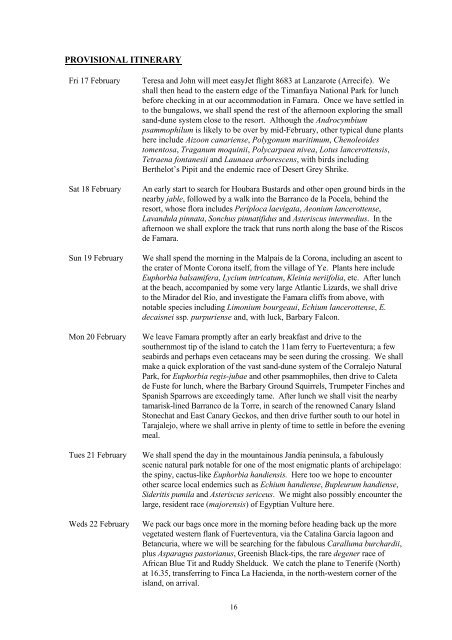Download - Botanical Society of the British Isles
Download - Botanical Society of the British Isles
Download - Botanical Society of the British Isles
- No tags were found...
Create successful ePaper yourself
Turn your PDF publications into a flip-book with our unique Google optimized e-Paper software.
PROVISIONAL ITINERARYFri 17 FebruarySat 18 FebruarySun 19 FebruaryMon 20 FebruaryTues 21 FebruaryWeds 22 FebruaryTeresa and John will meet easyJet flight 8683 at Lanzarote (Arrecife). Weshall <strong>the</strong>n head to <strong>the</strong> eastern edge <strong>of</strong> <strong>the</strong> Timanfaya National Park for lunchbefore checking in at our accommodation in Famara. Once we have settled into <strong>the</strong> bungalows, we shall spend <strong>the</strong> rest <strong>of</strong> <strong>the</strong> afternoon exploring <strong>the</strong> smallsand-dune system close to <strong>the</strong> resort. Although <strong>the</strong> Androcymbiumpsammophilum is likely to be over by mid-February, o<strong>the</strong>r typical dune plantshere include Aizoon canariense, Polygonum maritimum, Chenoleoidestomentosa, Traganum moquinii, Polycarpaea nivea, Lotus lancerottensis,Tetraena fontanesii and Launaea arborescens, with birds includingBer<strong>the</strong>lot’s Pipit and <strong>the</strong> endemic race <strong>of</strong> Desert Grey Shrike.An early start to search for Houbara Bustards and o<strong>the</strong>r open ground birds in <strong>the</strong>nearby jable, followed by a walk into <strong>the</strong> Barranco de la Pocela, behind <strong>the</strong>resort, whose flora includes Periploca laevigata, Aeonium lancerottense,Lavandula pinnata, Sonchus pinnatifidus and Asteriscus intermedius. In <strong>the</strong>afternoon we shall explore <strong>the</strong> track that runs north along <strong>the</strong> base <strong>of</strong> <strong>the</strong> Riscosde Famara.We shall spend <strong>the</strong> morning in <strong>the</strong> Malpaís de la Corona, including an ascent to<strong>the</strong> crater <strong>of</strong> Monte Corona itself, from <strong>the</strong> village <strong>of</strong> Ye. Plants here includeEuphorbia balsamifera, Lycium intricatum, Kleinia neriifolia, etc. After lunchat <strong>the</strong> beach, accompanied by some very large Atlantic Lizards, we shall driveto <strong>the</strong> Mirador del Río, and investigate <strong>the</strong> Famara cliffs from above, withnotable species including Limonium bourgeaui, Echium lancerottense, E.decaisnei ssp. purpuriense and, with luck, Barbary Falcon.We leave Famara promptly after an early breakfast and drive to <strong>the</strong>sou<strong>the</strong>rnmost tip <strong>of</strong> <strong>the</strong> island to catch <strong>the</strong> 11am ferry to Fuerteventura; a fewseabirds and perhaps even cetaceans may be seen during <strong>the</strong> crossing. We shallmake a quick exploration <strong>of</strong> <strong>the</strong> vast sand-dune system <strong>of</strong> <strong>the</strong> Corralejo NaturalPark, for Euphorbia regis-jubae and o<strong>the</strong>r psammophiles, <strong>the</strong>n drive to Caletade Fuste for lunch, where <strong>the</strong> Barbary Ground Squirrels, Trumpeter Finches andSpanish Sparrows are exceedingly tame. After lunch we shall visit <strong>the</strong> nearbytamarisk-lined Barranco de la Torre, in search <strong>of</strong> <strong>the</strong> renowned Canary IslandStonechat and East Canary Geckos, and <strong>the</strong>n drive fur<strong>the</strong>r south to our hotel inTarajalejo, where we shall arrive in plenty <strong>of</strong> time to settle in before <strong>the</strong> eveningmeal.We shall spend <strong>the</strong> day in <strong>the</strong> mountainous Jandía peninsula, a fabulouslyscenic natural park notable for one <strong>of</strong> <strong>the</strong> most enigmatic plants <strong>of</strong> archipelago:<strong>the</strong> spiny, cactus-like Euphorbia handiensis. Here too we hope to encountero<strong>the</strong>r scarce local endemics such as Echium handiense, Bupleurum handiense,Sideritis pumila and Asteriscus sericeus. We might also possibly encounter <strong>the</strong>large, resident race (majorensis) <strong>of</strong> Egyptian Vulture here.We pack our bags once more in <strong>the</strong> morning before heading back up <strong>the</strong> morevegetated western flank <strong>of</strong> Fuerteventura, via <strong>the</strong> Catalina García lagoon andBetancuria, where we will be searching for <strong>the</strong> fabulous Caralluma burchardii,plus Asparagus pastorianus, Greenish Black-tips, <strong>the</strong> rare degener race <strong>of</strong>African Blue Tit and Ruddy Shelduck. We catch <strong>the</strong> plane to Tenerife (North)at 16.35, transferring to Finca La Hacienda, in <strong>the</strong> north-western corner <strong>of</strong> <strong>the</strong>island, on arrival.16
















